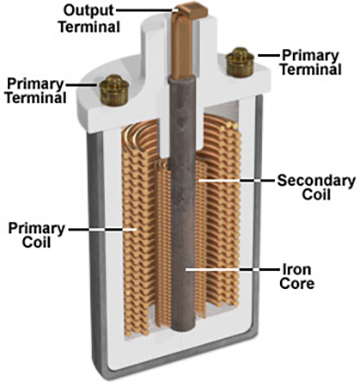Electric, solar-powered and alternate fuel vehicles are the wave of the future, but for now most cars run on gasoline, which they burn in an internal combustion engine to convert into motion.
For combustion to take place, a spark is needed to ignite the fuel mixture in the engine. The vehicle’s ignition system is designed so that a 12-volt battery can generate the very high voltage required to create such a discharge. The heart of this system is a device called an ignition coil.

This coil is a kind of transformer. Transformers transfer voltage from one circuit to another. The key principle that makes transformers work is electromagnetic induction: A moving magnetic field, or a change in a stationary magnetic field can induce a current in a wire exposed to that field.
This ignition coil consists of two coils of wire, as shown in the diagram. The secondary coil has far more turns of wire than the primary coil, which is wrapped around the secondary. This allows some 40,000 volts of electricity to be generated by a modest battery.